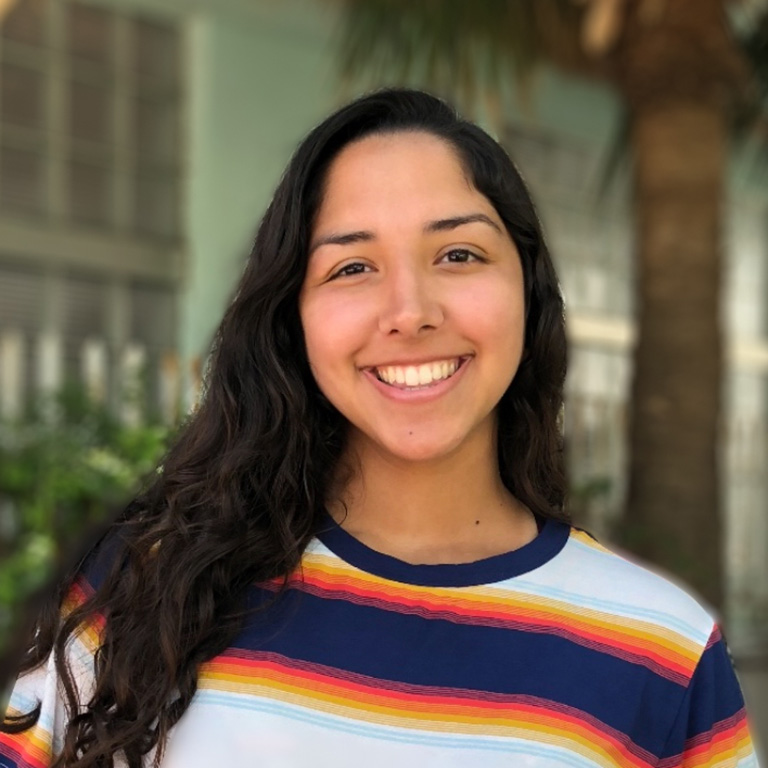This Q&A series highlights McKinney Climate Fellows alumni and their professional journeys within Indiana and beyond. The McKinney Climate Fellows program, administered by Indiana University’s Environmental Resilience Institute and Integrated Program in the Environment, connects IU undergraduate and graduate students interested in climate, sustainability, and community resilience with career experiences.
Growing up near the steel mills of Northwest Indiana, Angelica Lopez witnessed firsthand the toll that heavy industry can have on public health and the environment. With the vision for a more equitable and sustainable future in mind, Lopez helped create a regional greenhouse gas inventory—an early step toward developing a climate action plan—for the three-county area as a McKinney Climate Fellow in 2020.
Having graduated from IU Bloomington in 2021 with a degree in biology and a certificate in underwater resource management, Lopez currently works as a grants administrative associate for the McKinney Family Foundation, which is committed to realizing an environmentally sustainable future for Indiana.
The following interview has been edited for length and clarity.
What major project did you work on during your McKinney Climate Fellows placement?
I participated in McKinney Climate Fellows during the summer of 2020 and was placed with the Northwest Indiana Regional Planning Commission (NIRPC), a planning organization that facilitates coordination between local governments in Lake, Porter, and LaPorte counties.
At NIRPC, we were tasked with doing a regional greenhouse gas inventory for 11 different cities and towns and the three counties. Personally, I did three of those inventories myself for the cities of Merrillville, Lake Station, and Hobart. Since my time at NIRPC, this work has grown to include 16 communities.
What did you learn as a McKinney Climate Fellow and how did it inform your career path?
As a McKinney Climate Fellow, I was questioning whether or not this was the work I wanted to do. After a bit, I realized that the field of sustainability was so broad that I knew I could find something that aligned with my career goals. When I graduated, I worked as an aquarist for a bit, taking care of sharks, rays, and jellyfish, which was really fascinating. After realizing I wanted more fulfillment from my job, I returned to the sustainability field because I could make a greater difference in people’s lives.
What called you to pursue a career focused on climate and sustainability and why did you decide to do this work in Indiana?
Growing up in Northwest Indiana around the heavy industry there, I knew a lot of steel mill workers. You could see the fires blazing in the mills from afar, and I never thought anything of it at the time. As I got older, I realized how much these activities can impact the health of the people in my community, including my family and friends, many of whom still work at the mills now. These jobs give people stability and money, but they can also harm them and the surrounding environment. This firsthand experience informed my view that Indiana needs a whole lot of help to improve environmental health and build climate resilience.
What is your current position and what responsibilities does your job include?
As a grants administrative associate at the McKinney Family Foundation, I have been able to build up the foundation’s capacity to convene stakeholders and make connections to uplift organizations working to create an environmentally sustainable future in Indiana. It has been great to be involved in this pivotal organization, and I have admired the dedication that the McKinney Foundation has in pursuing environmental justice and renewable energy in Indiana for quite some time.
What do you like about your current job?
I found that one of my biggest contributions at the McKinney Family Foundation has been building our capacity to communicate more with our grantees and build stronger relationships. We spend a lot of time convening events and bringing more resources to Indiana to foster connections. Just this year, I started a pilot program to connect local governments with technical assistance and federal funding in Indiana. There’s a lot of money coming in, but our cities and towns need assistance to track that information down.
What advice do you have for students who are considering a career in sustainability and the environment?
One thing I found to be very important is to not be afraid to go outside of your comfort zone and push your own limits to see what you’re capable of. Explore who you are as a person and ask questions of everyone.
Looking forward, what do you think young professionals interested in climate careers should know as they enter the workforce?
There is an increasing demand for sustainability jobs in Indiana. It’s not just working in an office setting, it’s also construction, utilities, manufacturing, and so much more. For example, installing solar panels is absolutely a path that’s available for students. We can’t ignore the trades because the workforce needs to develop in those areas, too, to meet the demand for sustainability workers. We need both kinds of people to meet the moment.
About the Environmental Resilience Institute
Indiana University’s Environmental Resilience Institute brings together a broad coalition of government, business, nonprofit, and community leaders to help Indiana and the Midwest better prepare for the challenges of environmental change. By integrating research, education, and community, ERI is working to create a more sustainable, equitable, and prosperous future. Learn more at eri.iu.edu.
About the Integrated Program in the Environment
Bringing together faculty, students and staff across 10 Indiana University schools, the Integrated Program in the Environment is a hub for academics, research, and activities focused on the environment. Administered by the O’Neill School of Public and Environmental Affairs, the School of Public Health, and College of Arts and Sciences, IPE is preparing the next generation of environmental and sustainability leaders. Learn more at environment.indiana.edu.



